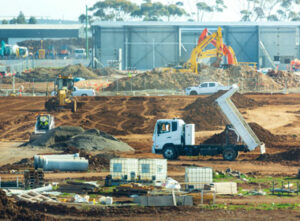In a variety of industries, the efficient disposal of organic materials is of supreme importance. One crucial tool that can manage waste and process biomass is the tub grinder. Designed to deal with various materials ranging from logs and stumps to agricultural waste and construction debris, tub grinders become known as versatile machines that can enhance productivity and protect the environment. However, what is a tub grinder? What is it used for? In this article, we will explore its definition and applications, and the differences between a tub grinder and a horizontal grinder.

(Image source: unsplash.com)
What is a tub grinder?
A tub grinder is widely used in the forestry and recycling industries to grind various organic materials, such as wood, brush, and agricultural residue, into smaller particles. By reducing the sizes of these materials, tub grinders can turn them into valuable and salable products, such as mulch, boiler fuel, and compost, just to name a few. In addition, tub grinders can also be employed to decrease the volume of these materials, thus reducing transportation requirements and saving costs on dumping.
In the early 80’s, tub grinders were originally designed for green waste recycling, turning the waste wood into boiler fuel. Later, tub grinders were used in landfills to reduce green waste. Besides, in composting operations, tub grinders help create mulch that is a carbon source. Nowadays, with the development of landscape mulch, tub grinders are popular in this industry.
Tub grinders in various sizes are available, equipped with different horsepower. They can deal with a variety of green waste, including debris piles, logs, stumps, leaves, and C&D materials.
Popular tub grinder brands include Vermeer, Morbark, Hogzilla, Duratech, WHO, and EarthSaver.
Components
Tube grinders are heavy equipment with a complex structure, but three components are quite important: the mill, the engine, and the tub size.
- The mill
Tub grinder mills are usually cylindrical. Hammers are equipped on the surface of the mill and divided into two types: fixed hammers and swing hammers. Fixed hammers are ideal for handling harder and larger materials such as logs and stumps and are often used with a larger tub grinder, while swing hammers are perfect for processing smaller materials such as wood chips and bark. Tub grinder tips are also of great importance. They are mounted on the hammers to finish the grinding job. Since grinder tips directly contact the material, they are covered by a layer of tungsten carbide grits, welding onto the surface. In this way, grinder tips are extremely durable and efficient during operation.
- The engine
The engine matters a lot because it gives the grinder the power to operate. With a higher horsepower, tub grinders have more possibilities in terms of the material type they can handle. Larger engines are suitable for processing logs and stumps.
- The tub size
The tub size determines the size of support equipment, such as the excavator and the loader. Choosing the right tub size can ensure that the work goes well.
Tub grinder vs horizontal grinder
There are two types of wood grinders: tub grinders and horizontal grinders. Here are the differences between them.

(Image source: rotochopper.com, morbark.com)
- Grinding material sizes
When it comes to processing longer materials like tree trunks, horizontal grinders are more efficient. But, if you are going to grind a bunch of stumps, you should use a tub grinder. Both grinders are suitable for handling loose green waste, but tub grinders are more efficient.
- Finished products
Tub grinders are capable of grinding raw materials instead of achieving finished products. Horizontal grinders are more controllable and can grind materials into small pieces in required sizes, which are quality finished products like landscape mulch.
- Horsepower efficiency
The horsepower efficiency of a tub grinder may be subject to variation because the feed material may either float on the rotor or be quickly sucked into the grinding chamber. Feed rates of a tub grinder are controlled by gravity and tub rotation, so grinding efficiency is greatly influenced by the consistency of feedstock. Light materials can easily float on the surface of the rotor due to low gravity, whereas heavy materials can enter too quickly, leading to rotor lugging or plugging.
Thanks to the in-feed conveyor, the feedstock can be delivered into the grinding chamber steadily. The feed roll allows the grinder to control the feeding speed, making the machine much more controllable than a tub grinder.
- Safety
As we mentioned above, a tub grinder may cause the rotor lugging, thus easily throwing objects outside of the machine. A horizontal grinder may also throw objects like a tub grinder does. However, the probability is lower and objects will not be thrown that high.
- Space
People always say that a tub grinder needs more space than a horizontal grinder. These two types of wood grinders need similar sizes of space for operations. However, a tub grinder’s possibility of throwing objects requires more open space surrounding it.
KoneCarbide supplies outperformed wood grinder teeth/tips/inserts made from solid steel covered with high-grade tungsten carbide. As a supplier equipped with rich experience in the tungsten carbide industry, we can ensure the excellent durability and performance of our wood grinder teeth. Contact us today to request a quote!









